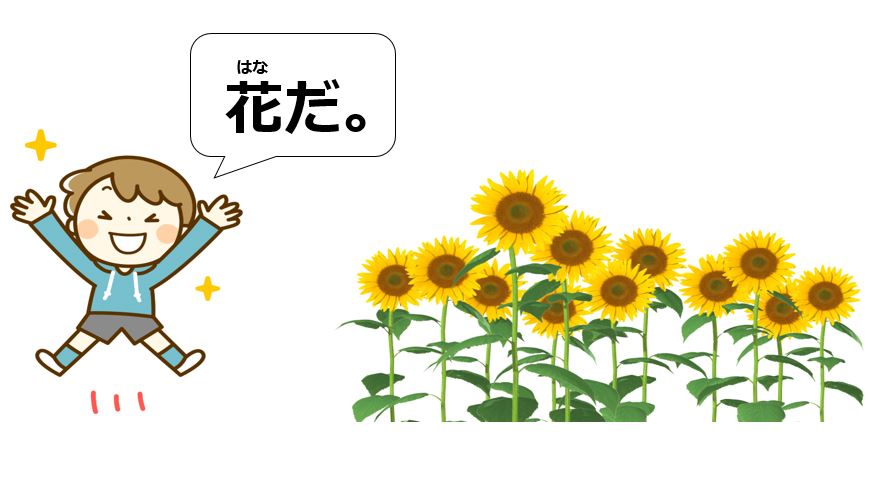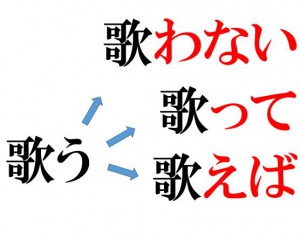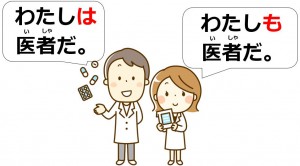When it comes to learning Japanese grammar as a beginner, it is important to understand that Japanese is different from your first language. Try not to apply the rules that your first language has into Japanese. By knowing Japanese grammatical rules step by step, you will certainly be able to construct Japanese sentences in place. Here, you will learn the most basic grammar by using Japanese nouns.
When Expressing State-of-Being, How Do Japanese Nouns Work?
A noun is a word that refers to a person, place, thing, event, etc. In general, nouns are used as subjects of verbs, objects of verbs, or complements of subjects. However, in Japanese, only a noun can become a sentence by attaching Hiragana: だ or です.
Expressing State-of-Being
| クリス(だ / です)。 [I’m] Chris. |
| 学生(だ / です)。 [I’m a] student. |
| 雨(だ / です)。 [It’s] rain. |
In Japanese, sentences without subjects are very common when the context clearly tells what or who you are referring to. That’s why only one Japanese noun is needed to become a sentence. What you need to do is just to attach だ or です after a noun. It’s easy, isn’t it? Then, what is the difference between だ and です?
Japanese Politeness
| Casual | クリスだ。 |
| Polite | クリスです。 |
In Japanese, you can express politeness at the end of sentences. だ and です have the same meaning; however, the nuance is different. Each sentence pattern can have both expressions: casual and polite.
[adsense]
| クリス。 [I’m] Chris. |
| 学生。 [I’m a] student. |
| 雨。 [It’s] rain. |
In casual-spoken Japanese, you can actually omit だ. However, we recommend you firstly memorize polite expressions if you are an adult and use Japanese in public. When you introduce yourself to people whom you have met for the first time, Japanese people need to use です. Otherwise, they will look rude.
Expressing Negative State-of-Being
| クリス(じゃない / じゃありません)。 [I’m] not Chris. |
| 学生(じゃない / じゃありません)。 [I’m] not a student. |
| 雨(じゃない / じゃありません)。 [It’s] not rain. |
Instead of だ and です, you just need to attach じゃない and じゃありません. Then, it will become the negative form.
Japanese Politeness
| Casual | 学生じゃない。 |
| Polite (colloquial) | 学生じゃないです。 |
| Polite | 学生じゃありません。 |
In the negative forms, there is a colloquial expression. Although it is not officially correct, you can express the polite-negative form by attaching です with じゃない. You can mostly hear this expression in conversations. Considering the frequency of use, you should be familiar with both of them.
| Non-polite | 学生ではない。 |
| Polite (colloquial) | 学生ではないです。 |
| Polite | 学生ではありません。 |
If you would like to be more formal, you can replace じゃ with では. This is more suitable when you talk with business partners, write a letter, make a public speech, etc.
Noun の Noun
When you want to modify a noun using another noun like “city of Japan,” how should it be? You can utilize の for the expression. の is a member of the class of words called “particles” that connects between words and indicates how the words relate to the rest of the sentence. They will enable you to express various things in Japanese, which you will carefully learn later on. Let’s briefly check how it works.
| 日本の都市: city of Japan |
| 車の窓: window of car |
| 日本語の本: Japanese book |
Don’t memorize that の is equivalent to “of” in English. Again, try not to apply the rules of your first language into Japanese because they are different languages. In Japanese, 日本語 is a noun, but in English “Japanese” can work as an adjective (*third example). Let’s learn Japanese grammar as it is.
| 日本の都市(だ / です)。 [It’s a] city of Japan. |
| 車の窓(だ / です)。 [It’s a] window of a car. |
| 日本語の本(じゃない / じゃありません)。 [It’s] not a Japanese book. |
When you attach (だ / です) or (じゃない / じゃありません)you can express state-of-being as well.
Supplementary Learning: the Concept of the Plurality
Japanese doesn’t have the equivalent of the singular “a” and the plural “-s.” We have put “[it’s a]” just for the sake of translation. We cannot identify whether it is a singular or plural number without background information.
Summary
- You can express state-of-being by attaching だ or です.
- You can express negative state-of-being by attaching じゃない or じゃありません.
- Sentences without a subject are common.
- There are casual, polite (colloquial), and polite (formal) expressions.
- You can express various things using particles (Ex. noun の noun).
- Japanese doesn’t have the equivalent of the singular “a” and the plural “-s.”
In this article, we have explained Japanese grammar assuming that subjects are clear enough to omit. What should you do when it is not clear what you are talking about? Next, you will learn how to clarify subjects or topics.





